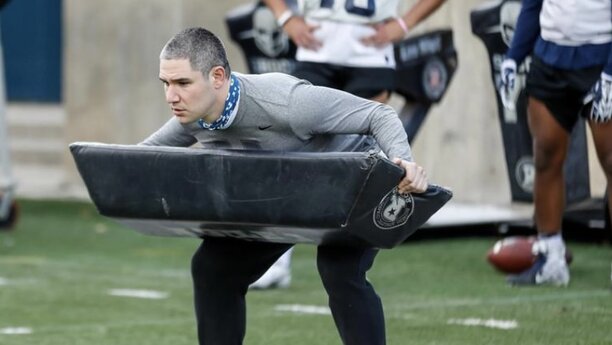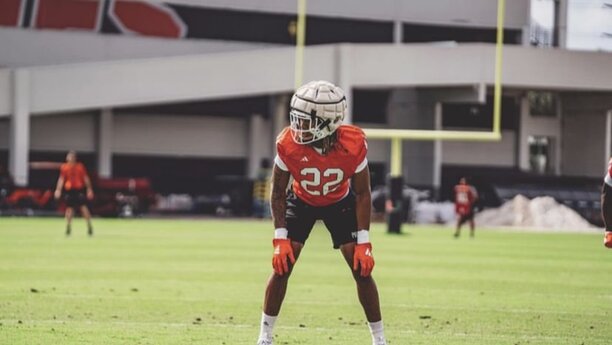Message boards are full of so-called experts who never played or coached the game at the high levels. I’m one of them. CanesInSight is blessed to have Mike Zuckerman, a ten-year college coaching veteran, take us to Football School. He will join the show regularly to provide insight on terms we use every day, but may not fully understand. Zuck, a Miami alum, spent seven years in UM’s football program in various roles and, for the past three years, served as the linebackers coach at Utah State. During his tenure, Utah State had an 11-win season, won the conference, and produced 2023 first-team All-Conference LB MJ Tafisi. Zuck has taken a leave of absence to return to civilian life, which is a blow for Utah State but a blessing for Canes fans.
In this week’s Football School, he explains what he looks for when evaluating a high school linebacker for college football.
On the first thing he looks for: One of the most interesting things I ever heard about linebacker play is: when you look at Pop Warner or little league football, the most athletic kid gets put at quarterback or running back so he can touch the ball every play. Everyone gets placed by their skill set. The biggest kids get put on the line, all that stuff. The linebacker is normally not any one shape or size. It's normally the best football player. The most instinctual guy on that team gets put at the spot from a young age.
I've always believed there is no one linebacker type. It's the most instinctual position on the field because you're playing in a short area of space with movement in front of you. You have to understand schemes. You have to understand pass coverage. And you have to understand how everything in front of you and behind you plays.
So that's the number one thing when you start looking at linebackers. Obviously, everybody wants the 6’3, 250-pound long-armed guy who can run. But there's not a ton of those people out there. The biggest thing, after your initial non-negotiable measurables, is that you're finding a guy who instinctually feels the game. He’s smart and is tough. Especially at a place like Utah State.
Being at Miami forever, that's more looking at the cream of the crop and then figuring out which ones are the perfect fit for you. When you go down a level, when you're at the Group of Five or you're recruiting FCS, D2, D3, you need to find the best football players and be willing to figure out where you’re willing to sacrifice. If they have every single skill I just described, they're going to Miami, they're going to an SEC school.
So that smart and toughness factor is the number one thing in any linebacker. Because we've all seen it. You've seen a million guys who look like a million bucks and can run super fast and just can't make a play a linebacker. There's so much reactional thinking that has to go on there. That's my non-negotiable is they've got to be a football player, period. Obviously, we'll look at height and length and all those things, but they've got to be able to make a play.
On the difficulty of projecting linebackers to the next level: Linebacker is extremely difficult because you can have every physical attribute and get to college and not be able to see the game. Corey [Flagg] is such an awesome example. The guy went through so many coaching staffs and no one could beat him out. Everyone kept putting him on the field and he kept making plays.
When Blake Baker recruited Corey, he went and saw him and he was brilliant. The way he practiced and the way he led, he took something from the board and immediately learned it. He could see the game extremely well and he tackled well. And he played fast. I don't know what 40 times Corey would run, but he played fast.
I look at my time at Miami and how many different body types we had. When I was in school, I absolutely loved watching Sean Spence. I was in the same class as him, and Sean was 6'1, maybe 205 pounds as as a freshman and got up to about 220 at the most. He was long and could run. But the biggest thing was he was brilliant. He saw the game ridiculously well.
You look at Denzel Perryman. Denzel was thick, but he was 5'10 at best. But again, extremely explosive hitter who saw the game extremely well. Shaq Quarterman's more built like your typical Mike, but he saw the game extremely well. Mike Pinckney, he's more undersized, but just incredible instincts.
That's why the biggest thing to me in linebacker recruiting is you have to talk to the kid. You have to watch him practice. You have to talk ball, see if he understands what's going on and really truly sees the game.
On linebackers who play running back: One thing that I loved looking for, especially being at Utah State, was running back instincts. Because it's very hard sometimes to see instincts as a linebacker on linebacker film. All respect to high school coaches. The best coach I know in the world is a high school coach. But a lot of times when you don't have the coaches to really drill down on every position, a lot of linebacker play in high school is “go tackle the guy with the ball.” Like I said, no disrespect to anybody, but a lot of times that does happen on the high school level. And the first time a linebacker is taught to read things and react, and not just chase where he thinks the ball is, is in college. And he can't do it.
When you see running back film, however, the vision can translate as a linebacker. That's a way you can use high school film to evaluate whether this guy can see what's going on. Because if you really think about it, linebacker play is reverse running back play. Yes, you have gaps and you have responsibilities and everything like that. But you are tracking to the first opening. The running back is tracking to run into that first opening. If you understand what's going on and can meet him there, then you're going to be a good linebacker.
On watching former FSU LB Jeff Luc and other highlight reel sensations: Before I was truly involved and had learned how to evaluate film, I watched [Jeff Luc tape] in a dorm room in Miami and thought, “Oh my God, this guy's the best linebacker of all time.” But one thing you learn with a lot of highlight tapes – because there's a lot of kids out there who have tapes just smashing people– is almost every single thing that he does on this tape is in a straight line.
A big red flag to me is if I don't see you change direction on tape. Or the one or two times you do change direction, it doesn't look fluid. Because very little in linebacker play is running in a straight line. It's almost all short, choppy movements and how quickly you can change direction within that box.
How do you maneuver in that box? How well do you change direction? Can you tackle a guy in a short amount of space and make the necessary changes in direction to make that tackle?
One of the older coaches at Utah State taught me this early and because he had been down more. I'd spent most of my career in Miami. He'd been at Arkansas State before we came to Utah State and had spent his career mostly D2. He was like, “You won't believe how many coaches don't go back and watch the game tape.” He's like, “We've got HUDL now. Back in the day, it was hard to get full game tape. We've got HUDL. You need to go watch the entire game and make your own cut ups.” We call them profile tapes, which is not a highlight tape. It's a cut up of every time you do anything good or bad. In the NFL, that's what they do with every prospect. When you see a highlight tape and you're not sure, you need to go watch that game tape, especially for linebackers. That's going to tell you a lot.
There's been kids where it’s like, “Man, this guy's awesome.” And then the only good plays he has were those three minutes on the highlight tape. And there are horrible plays on there. Whereas conversely, there's some kids where you think “He's OK.” And you go watch him in a game and it’s, “Oh, my God, I love this guy.” I’ve had both of those.
For the full Podcast, which includes Coach Zuck’s breakdown of Miami commit Elijah Melendez, click the video above, watch on YouTube or subscribe on all major podcast platforms.
Previous Football School articles:
Does Miami Really Run the Air Raid?

Football School: Does Miami really run an Air Raid?
Message boards are full of so-called experts who never played or coached the game at the high levels. I’m one of them. CanesInSight is blessed to have Mike Zuckerman, a ten-year college coaching veteran, take us to Football School. He will join the show regularly to provide insight on terms...
What's the Difference Between Sam, Striker and Nickel?

Football School: What’s the difference between Sam, Striker and Nickel?
The strong-side linebacker position has been the source of endless debate on the CanesInSight forums. “Why is Zach McCloud lined up over a WR?” “What's a striker?” Coach Mike Zuckerman, a 10-year coaching vet who was at Miami when they began employing the “striker,” takes us to Football...






